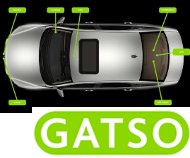2/22/2013
New Moving Speed Camera Blends With Freeway TrafficFrench agency grants type approval to a car-mounted speed camera that issues tickets while driving.

Soon the car behind you on the freeway might be carrying a speed camera. The "Gatso Millia" moving photo radar system is installed in an inconspicuous sedan in the hopes of catching nearby motorists by surprise, photographing them on the highway unaware of what happened until a citation appears in the mail weeks later. The reference laboratory LNE (Laboratoire national de metrologie et d'essais) granted type approval to the device on Monday, certifying it as fit for use on French roads.
Conventional photo enforcement devices monitor traffic while stationary. Even "mobile" photo radar vans stop on the side of the road when issuing citations. As a result, most drivers slam on the brakes before approaching a known speed camera site, only to speed up after passing the device in order to make up for the lost time. The new system is meant to create roving speed traps that even careful drivers would find difficult to avoid. Police have had dashcam systems combined with radar that provide speed readouts of target vehicles while moving, but this is the first system designed to operate in a fully automated mode.
"The modular components of this configuration are built into the car so that it can be operated in an ergonomic way," the Gatso Millia brochure explains. "One of the major advantages is that the appearance of the vehicle is not affected. For enforcement in both directions, the in-car solution can be incorporated both in the front and/or the rear of the car."
Gatso Millia uses an ordinary K-band doppler radar antenna and flash module installed on the front or rear bumper of the automobile. Batteries, the flash generator and the computer module are installed in the trunk.
The certification noted a number of limitations with the technology: The device is configured to issue a ticket only if the target vehicle is driving 20km/h (12 MPH) faster than the camera vehicle; the camera does not function in extreme temperatures of -4 degrees Fahrenheit; and it cannot work on a road more than four lanes wide.
The system claims to read speeds between 12 MPH and 155 MPH. A GPS unit adds geographic coordinates to the citation photograph and video so that the authorities can verify the alleged speeding took place within a particular jurisdiction. The only human intervention needed is to have the speed camera driver enter the correct speed limit.
Based in The Netherlands, Gatso supplies speed cameras to many of the photo ticketing firms that operate in the United States. Gatso first began making automated ticketing machines more than fifty years ago.


